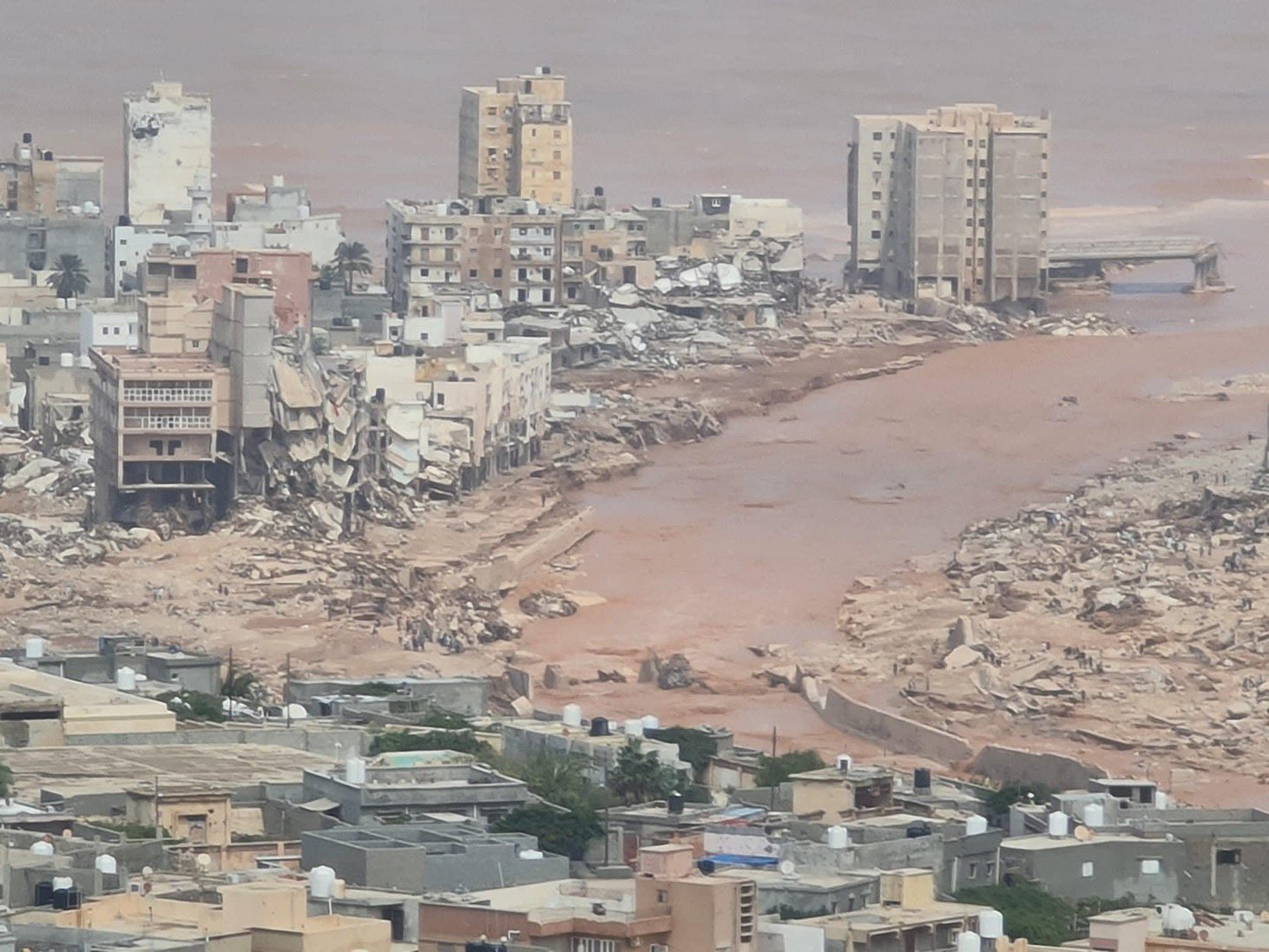
Daniel dropped eight months of rain on Libya’s northeast region.
On Sept. 11, two dams collapsed, sending 1 billion cubic feet (30 million cubic meters) of water into already inundated areas. The eastern city of Derna, home to less than 100,00 people, was hit worst, with 25% of the city disappearing, according to the Minister of Civil Aviation. Images on social media reveal the scale of destruction in the city.
On Sept. 19, the UN Office for the Coordination of Humanitarian Affairs said, “Destroyed bridges and blocked roads have severely disrupted local food supply chains, hampering access to markets and causing food shortages. Lack of updated reliable data on the impact of the floods due to access challenges is delaying much-needed relief efforts.”
Dax Bennet Roque, the Norwegian Refugee Council’s country director for Libya, said on Sept. 12, “Communities across Libya have endured years of conflict, poverty and displacement. The latest disaster will exacerbate the situation for these people. Hospitals and shelters will be overstretched amidst the large wave of displacement.”
Storm Daniel had devastating impacts across the Mediterranean the week of Sept. 4, including deadly flooding in Greece, Turkey and Bulgaria, leading to 20 deaths. The storm is known as a “medicane”, which AccuWeather describes as a tropical stormlike cyclone that forms when a non-tropical storm feeds off the warm waters of the Mediterranean. Medicane is a combination of the two words “Mediterranean” and “hurricane.”
A Reuters report on Sept. 12 said, “Derna is bisected by a seasonal river that flows from highlands to the south, and normally protected from flooding by dams.” The collapse of two dams is a major infrastructure failure and raises the prospect of further flooding should additional rainfall occur.
Communications remain disrupted in Derna, impeding rescue and relief efforts. Across affected areas, there are reports of damage to homes, roads, bridges and hospitals. Access to some areas is limited due to road damage. While a full count is not complete, at least 2,217 buildings have been exposed to flooding.
The dam reservoirs in Derna have caused at least five floods since 1942, most recently in 2011. They were built in the 1970s. Derna’s deputy mayor told Al Jazeera, “The dams have not been maintained since 2002, and they are not big.”
The Derna Dam is about 246 feet high with a capacity of almost 5 billion gallons, while the Mansour Dam is smaller at 148 feet and just under 400 million gallons. But the problems with the dams were known.
As reported in CNN, previous research had “warned that the dams in Derna had a ‘high potential for flood risk’ and that periodic maintenance is needed to avoid ‘catastrophic’ flooding.” This maintenance was not carried out due to the political conflict. The dams will need to be rebuilt and maintained.
Libya’s disaster vulnerability is increased by its political conflict, which has seen a power struggle between two rival administrations.
BBC explains, “Since 2014, Libya has been divided into competing political and military factions based in different parts of the country.” However, Libya’s woes precede 2014. According to the Council on Foreign Relations, “Libya has struggled to rebuild state institutions since the ouster and subsequent death of former leader Muammar al-Qaddafi in October 2011.”
Weak institutions make it difficult for governments to adequately invest in social services and help their population mitigate disaster risk. According to Leslie Mabon, lecturer in Environmental Systems at The Open University, the country’s complex politics “pose challenges for developing risk communication and hazard assessment strategies, coordinating rescue operations, and also potentially for maintenance of critical infrastructure such as dams.”
Deadly fighting between the two largest armed groups in the Libyan capital, Tripoli, in late August served as a reminder of how severe the security situation is. In 2023, humanitarians already faced barriers to delivering aid in Libya, including administrative impediments and access constraints. The disaster will likely exacerbate these issues and may result in difficulties in providing immediate aid. As in all disasters, survivors and local volunteers are the first to respond and support their community.
According to NPR, “The disaster brought a rare moment of unity, as government agencies across the country rushed to help the affected areas. While the Tobruk-based government of east Libya is leading relief efforts, the Tripoli-based western government allocated the equivalent of $412 million for reconstruction in Derna and other eastern towns, and an armed group in Tripoli sent a convoy with humanitarian aid.”
There is the potential of a health crisis emerging as a significant number of bodies remain under debris. Damage to water and sanitation infrastructure raises concerns about the spread of waterborne diseases.
The Director General of the National Centre for Disease Control said 150 cases of illness due to water contamination had been reported.
Libya is entering its rainy season with an increase risk of disease outbreaks.
Most migrants and refugees go through Libya on their journey towards Europe. For years, migrants and refugees have endured abuses that are well documented. On Sept. 19, IOM reported that 406 migrants had died.
In 2022, the United Nations (UN) Human Rights Office released a report that found many migrants in Libya are compelled to accept assisted returns to their countries of origin “in conditions that do not meet international human rights laws and standards.”
According to the UN Office for the Coordination of Humanitarian Affairs, around 2,000 internally displaced people, 7,500 returnees and 4,400 migrants were living in Derna, where the worst devastation is located. Considering the pre-existing conditions these people faced, they will be particularly affected by the floods.
Damage assessments are ongoing, but the scale of the disaster means thousands of residential buildings have been damaged and become inhabitable. The disaster has displaced thousands.
According to IOM on Sept. 17, three schools in the west and three others in the east are hosting displaced households but these families are likely to be relocated. Most of the displaced people in the east are staying with relatives.